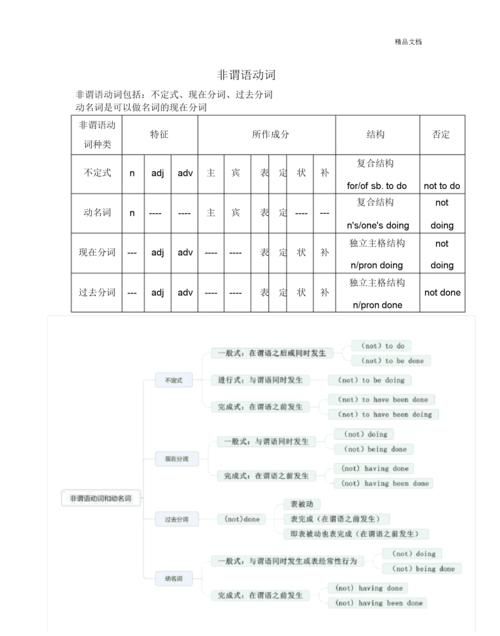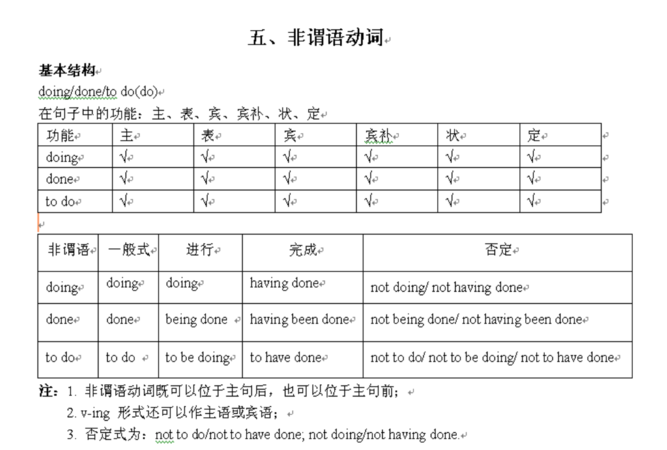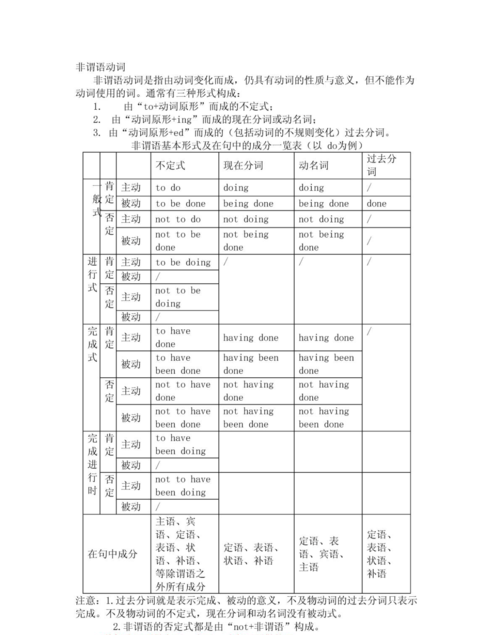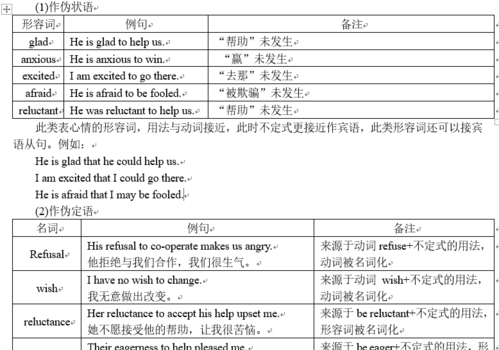本文目录
非谓语动词用法详解
简单一点讲:
谓语动词是与非谓语动词相对应的概念.两者都是动词,但是前者是作谓语成分,后者不能作谓语成分.而谓语成分就是用来说明主语的动作或状态的,一般由动词或短语动词承担.
比如:我看电视.”看”就是谓语.
你正在上网.”上网”也是谓语.
再举几个英语句子吧:i
see
a
girl.我看见一个女孩.”看见””see"就是这个句子的谓语.而see也是个动词,所以就叫做谓语动词.she
is
very
beautiful.她很漂亮."is"就是这个句子的谓语,也是动词.
而短语动词就是动词加小品构成的起动词作用的短语叫短语动词。例如:
turn
off
the
radio.
把收音机关上。(turn
off是短语动词)
短语动词的构成基本有下列几种:
1)动词+副词,如:black
out;
2)动词+介词,如:look
into;
3)动词+副词+介词,如:look
forward
to。构成短语动词的副词和介词都统称为小品词。
非谓语动词:在句子中充当除谓语以外的句子成分的动词形式叫做非谓语动词。非谓语动词也是动词,但不能作谓语,只能作主语、表语、宾语、补语、状语、定语。非谓语动词分为三种形式:不定式,动名词,和分词(分词包括现在分词和过去分词)。
1)不定式
时态\语态
主动
被动
一般式
to
do
to
be
done
完成式
to
have
done
to
have
been
done
2)动名词
时态\语态
主动
被动
一般式
doing
being
done
完成式
having
done
having
been
done
3)分词
时态\语态
主动
被动
一般式
doing
being
done
完成式
having
done
having
been
done
否定形式:
not
+不定式,
not
+
动名词,
not
+
现在分词

初三英语语法中最难的是哪部分单词
语法哪部分最难,可能因人而异,总体来说时态和语态,非谓语动词和情态动词比较难些,虚拟语气初中涉及到一点点。这儿是中考非谓语动词的讲解视频,可以看看
***.sohu.com/u/vw/4913620

非谓语动词讲解视频
非谓语动词,固然表示它不可能在句子中充当谓语,它的形式则是以动词为根基的衍生变换而已,譬如不定式、动名词、分词形式。
非谓语动词必然要谈及它的用法。该使用什么形式的非谓语动词(后面简称非谓语),本人觉得主要可分为两种情况,一种是固定搭配,譬如某些动词后面要求接动名词,而某些动词接不定式,又好像judge by..放句首多用-ing形式。另一种情况就是适时而定,掌握非谓语特定形式的用法,然后比对情境,选用相应的。譬如He hurry to the airport,just only to find that they have gone.其中使用不定式just only to find that they have gone只是表达出出乎意料的结果,不定式的这个用法多与only连用,便是出乎意料之意。其他非谓语动词还有很多用法,当然,首先必须了解语法。

非谓语动词用法详解
非谓语动词和谓语动词的相对时间关系 非谓语动词
相对谓语动词的时间意义 例句
一般式不定式
说明行为在谓语动词所表示的行为之后,多数是那些表愿望的词:want; hope; expect; wish等。 I want to go home.
I hope to see you.
说明行为与谓语动词表示的行为同时发生,多数是那些省略不定式符号的词,一般是复合宾语。 I saw him come in.
He helped him (to) carry things.
一般式动名词
表示动作与谓语动词表示的动作同时发出。 We enjoyed seeing the film.
I am thinking of taking over the job.
在动词insist on; rely on; count on(相信)等后表示动作在谓语动词表示的动作之后发生。 He insisted on doing that work
在有些明确表示时间先后的动词和介词on; upon after代替完成动名词表示的动作在谓语动词表示的动作先发生。 I remember seeing him before.
On arriving Beijing, he went to see his friend.
一般式分词
现在分词
持续性动词
说明分词表示的动作和句中谓语动词表示的动作同时发生。 He stood there speaking.
Holding a book under his arm, he entered the room.
终止性动词
说明分词表示的动作发生之后,句中谓语动词表示的动作立刻发生。 Entering the room, I found nobody in.
Turning to the right, you will find the post office.
过去分词
持续性动词
通常说明分词表示的动作,此句中谓语动词表示的动作先发生。 Written in simple English, the book is easy to read.
I can't find my lost pen.
说明分词表示的动作和句中谓语动词表示的动作并无先后。 He is a person well-known in this country.
代替完成式现在分词的被动语态。 Educated by the party, he became a brave fighter.
完成式不定式
说明行为动词在谓语动词表示的行为动词之前发生。 I'm sorry to have troubled you.
He is said to have come here.
He is thought to have done it.
He is believed to have done it.
He seemed to have known it.
在wish, hope, expect, intend, mean, suppose等动词过去时后,说明行为动词没有实现。 We wished to have done this.
I expected to have left by then.
(=I had expected to heave by then.)
完成式动名词
说明动名词表示的动作,此句中动词表示的动作先发生。 We regret having told you the news.
After having finished his work, he went home.
He denied having broke the glasses.
完成式分词
说明分词表示的动作,此句中谓语动词表示的动作先发生。多数表示一些瞬时间动词。如果是hear; see或表示位置转移的动词arrive; leave; turn; open.不用完成时 Having finished his work, he went home.
Sitting down with him, we begun to discuss it.
Hearing this, he rose and went to the door.
非谓语动词用法对比
知识要点:
一、不定式与动名词做主语:
1、动名词做主语往往表示普通的、一般的行为,不定式做主语常表示某次具体的行为。例如:
Collecting information about children’s health is his job. 收集有关儿童健康的信息是他的工作。
It’s necessary to discuss the problem with an experienced teacher. 与一位有经验的老师讨论这个问题是有必要的。
2、常用不定式做主语的句型有:
(1)It’s difficult (important, necessary) for sb. to do
(2)It’s kind (good, friendly, polite, careless, rude, cruel, clever, foolish, brave) of sb. to do.
3、常用动名词做主语的句型有:
It’s no good (use, fun) doing.
It’s (a) waste of time one’s doing.
It’s worth while doing.
二、不定式、动名词、分词做表语:
1、不定式做表语常表示谓语动词所表示动作之后发生的动作。
His teaching aim of this class is to train the students’ speaking ability. 他这节课的教学目的是要训练学生说的能力。
2、动名词做表语是对主语内容的解释,这时主语与表语位置可以互换,动名词常用于口语中。
Its full-time job is laying eggs. 它的(指蚁后)的专职工作是产卵。
3、现在分词做表语表示主语的性质与特征;进行时表示正在进行的动作。
The task of this class is practising the idioms. (现在分词做表语)
With the help of the teacher, the students are practising the idioms. (现在进行时)
4、常用作表语的现在分词有:interesting, amusing, disappointing, missing, puzzling, exciting, inspiring, following等。现在分词表示进行与主动。
The joke is amusing .这笑话很逗人。
The problem is puzzling. 这个问题令人不解。
5、过去分词作表语表示主语所处的被动状态或完成某动作的状态。而被动语态表示主语所承受的动作。
The village is surrounded by high mountains.(过去分词做表语)
The enemy was surrounded by the Red Army.(被动语态)
He is well educated.(过去分词做表语)
He has been educated in this college for three years.(被动语态)
常用在句中做表语的过去分词有:
used, closed, covered, interested, followed, satisfied, surrounded, done, lost, decided, prepared, saved, shut, won, completed, crowded, dressed, wasted, broken, married, unexpected等。
6、注意如下动词的现在分词与过去分词用法不同:
interest(使…感兴趣),surprise(使…吃惊),frighten(使…害怕),excite(使…兴奋),tire(使…疲劳),please(使…满意),puzzle(使…迷惑不解),satisfy(使…满意),amuse(使…娱乐),disappoint(使…失望),inspire(使…欢欣鼓舞),worry(使…忧虑)
它们的现在分词常修饰物(有时修饰人),表示主动,过去分词常修饰人,表示被动(包括某人的look、voice等)。例如:
Climbing is tiring. 爬山很累人。
They are very tired. 他们很疲劳
After hearing the exciting news, he gave a speech in an excited voice.
三、不定式与动名词做宾语:
1、下列动词跟不定式做宾语:
want, wish, hope, expect, ask, pretend, care, decide, happen, long, offer, refuse, fail, plan, prepare, order, cause, afford, beg, manage, agree, promise等。
2、在下列动词或动词短语后用动名词做宾语:
enjoy, finish, suggest, avoid, excuse, delay, imagine, keep, miss, appreciate, be busy, be worth, feel like, can’t stand, can’t help, think of, dream of, be fond of, prevent…(from), keep…from, stop…(from), protect…from, set about, be engaged in, spend…(in), succeed in, be used to, look forward to, object to, pay attention to, insist on等。
3、在forget, remember, stop, regret, try, mean等动词后跟不定式与动名词意义不同,不定式表示谓语动词之后的动作,而动名词表示的动作发生在谓语动词之前,常用一般式doing代替完成式having done.
He forgot to tell me to post the letter.(他忘了叫我发信。)
I shall never forget finding that rare stamp on an ordinary envelope. 我永远也忘不了在一个普通信封上发现了那枚珍贵的邮票。
Remember to write to us when you get there. 到那里,记得给我们写信。
I don’t remember meeting him. 我不记得见过他。
I regret to tell you that I can’t go to your birth-day party. 我很遗憾告诉你我不能去参加你的生日晚会了。
They regretted agreeing to the plan. 他们后悔同意这个计划。
He tried to pretend to share in the pleasure with his friend. 他尽力假装与朋友分享欢乐。
She tried reading a novel, but that couldn’t make her forget her sorrow. 她试着看看小说,但也不能使她忘记伤心事。
I didn’t mean to hurt you. 我没有企图伤害你。
A friend indeed means helping others for nothing in return. 真正的朋友意指不图回报地帮助别人。
4、动名词作need, want, require, be worth的宾语时,用主动式代替被动式。
The washing-machine needs repairing.(或用:needs to be repaired)这台洗衣机需要修理。
The point wants referring to. 这一点要提到。
This English novel is worth reading. 这本英文小说值得一读。
The situation in Russian required studying. 俄国形式需要研究。
四、不定式与分词在句中做宾语补足语:
1、以下动词后跟不定式做宾语补足语:
ask, tell, beg, allow, want, like, hate, force, invite, persuade, advise, order, cause, encourage, wait for, call on, permit, forbid
The doctor advised him to stay in bed for another few days. 医生嘱咐他再卧床休息几天。
We wish him to remain and accept the post. 我们希望他留下来接受这个职位。(注意hope后不跟不定式做宾补。)
2、有些动词后的复合宾语用不带“to“的不定式,这些动词有:see, watch, notice, hear, feel, make, let, have等。例如:
We noticed him enter the house. 我们留意到他进了那所房子。
The boss made them work twelve hours a day. 老板让他们一天干12小时工作。
注意当make、have不做“迫使、让”讲,而做“制造、有”解时,跟带有to的不定式做状语。
Mother made a cake to celebrate his birthday. 妈妈做了一个蛋糕给他庆贺生日。
He had a meeting to attend. 他有个会要开。
3、下列动词后的复合宾语用分词做宾补:see, watch, notice, observe, hear, feel, make, set, have, leave, keep, find等。用现在分词还是用过去分词做宾补,要看分词与宾语的关系。例:
We heard him singing the song when we came in. 当我们进来的时候,听见他正唱那首歌。
We have heard the song sung twice. 我们听过这首歌唱过两遍了。
五、非谓语动词做定语:
1、不定式做定语放在所修饰的名词后,表示在谓语动词之后发生的动作或过去的某一特定动作。例如:
He had no house to live in but a lot of work to do. 他没有房子住却有好多活要干。
Our monitor is the first to arrive. 我们班长是第一个到的。
2、动名词与现在分词做定语的区别:
动名词做定语说明所修饰名词的用途;现在分词做定语,表示所修饰名词进行的动作。
a walking stick 拐杖(动名词做定语,意为a stick for walking)
a sleeping car 卧铺车厢(动名词做定语,意为a car for sleeping)
the rising sun 正在升起的太阳(现在分词做定语,意为the sun which was rising)
the changing world 变化中的世界(现在分词做定语,意为the world which is changing)
3、现在分词与过去分词做定语的区别:过去分词做定语表示完成或被动的动作,现在分词做定语表示主动或进行的动作。如:
a piece of disappointing news 使人失望的消息(意同a piece of news which disappointed us)
in the following years 在后来的几年中(意同in the years that followed)
a well dressed woman 衣着讲究的女士(意同a woman who is dressed well)
a car parked at the gate 停在门口的小汽车(意同a car which was parked at the gate)
六、不定式与分词做状语:
1、不定式做状语,只表示目的、结果或原因:
He hurried home only to find his money stolen. 他匆忙赶到家中,发现钱被盗了。(结果状语)
To make himself heard, he raised his voice. 为了被听清楚,他提高了嗓门。(目的状语)
All of us are surprised to see his rapid progress. 看到他的进步,我们都很吃惊。(原因状语)
2、分词做状语可表示时间、条件、原因、伴随、让步、方式:
Seen from the top of the hill, the town is beautiful. 从山上看,这座城市很美。(条件状语)
Coming into the room, he found his father angry. 当走进房间时,他发现父亲生气了。(时间状语)
Being tired, they went on working. 虽然累了,但他们继续工作。(让步状语)
Having been hit by the big boy on the nose, the little boy began to cry. 由于被大孩子打了鼻子,那个小男孩哭了。(原因状语)
He put a finger in his mouth, tasted it and smiled, looking rather pleased. 他把一个手指放进嘴里,尝了尝,笑了,看起来挺高兴。(伴随状语)

以上就是关于初中非谓语动词视频讲解 ,非谓语动词用法详解的全部内容,以及初中非谓语动词视频讲解 的相关内容,希望能够帮到您。
